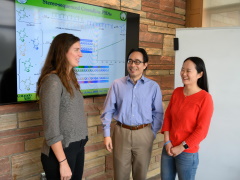Features
Catalyzing bioplastic production
Date: 2019-11-29 15:19:09.0
Author: Jon Evans

Eugene Chen (middle) and Xiaoyan Tang
(right), together with colleague Andrea Westlie
(left), in the CSU Chemistry Research
Building.
Photo: John Eisele/Colorado State University
Photography.
Poly(3-hydroxybutyrate) (P3HB) has a lot going for it as a bioplastic. For a start, it has similar properties to polypropylene, but will readily biodegrade in landfills and the ocean. Furthermore, it is pretty versatile. As one of a family of biopolymers known as polyhydroxyalkanoates (PHAs), produced by various microbes for energy storage, it is usually combined with one of the other 150-odd members of this family to form a copolymer. Because different P3HB copolymers possess slightly different physical properties, they can be used to produce a wide range of different products, from bottles, cups and plates to food packaging to biodegradable scaffolds for tissue engineering.
Despite these clear benefits, P3HB is held back by the fact that it has to be produced by microbes in bioreactors, which prevents it from being manufactured in large volumes at low cost. This has spurred scientists to look for non-biological routes for producing P3HB, based on catalysts rather than microbes, which would offer more scope for cheap, large-scale production.
Several such routes have been found, including reacting propylene oxide with carbon monoxide and linking together a monomer of 3-hydroxybutyric acid (3HB) called beta-butyrolactone via ring-opening polymerization. But these routes are not very efficient and tend to produce P3HB with poorer physical properties than the microbial version. In addition, actually producing the propylene oxide and beta-butyrolactone in the first place is fairly difficult, requiring various catalytic steps, especially if producing it from biological material.
Then, last year, two chemists from Colorado State University (CSU) in Fort Collins, US, Eugene Chen and Xiaoyan Tang, developed a new and improved catalytic process for producing P3HB. This was based on the ring-opening polymerization of beta-butyrolactone, but rather than utilize a monomer comprising one unit of 3HB they employed a dimer comprising two. Specifically, they used a dimer known as cyclic diolide, which can be readily obtained from biological material via succinate.
As they reported in a paper in Nature Communications, by experimenting with various metal-based catalysts, they were able to find an yttrium-based catalyst that could efficiently convert cyclic diolide into P3HB via ring-opening polymerization. Furthermore, this version of P3HB had similar physical properties to the microbial version, including molecular weight and melting temperature.
Now, they have gone a stage further and produced a newer and even more improved catalytic process. Because 3HB is a chiral molecule, existing as two different mirror-image enantiomers, cyclic diolides can be either chiral or achiral, depending on whether they are made up of the same or different enantiomers. But the yttrium-based catalyst that Chen and Tang developed would only work with chiral cyclic diolides, meaning the non-chiral form would simply go to waste, potentially ruining the economics of the whole process.
So, together with a couple of other colleagues, Chen and Tang looked to develop a catalyst that could work with the non-chiral form, eventually coming up with a lanthanum-based catalyst that did the trick. As the chemists report in a paper in Science, combining their two catalysts together in a one-pot process meant they could convert both chiral and achiral forms of cyclic diolide into P3HB with similar physical properties to the microbial version.
To be really useful, though, this P3HB would need to be combined with other PHAs to form a range of copolymers with different physical properties, but Chen and Tang think their process can help with this as well. For a start, they found they could finely tune the properties of the P3HB by simply reacting together different proportions of the chiral and achiral forms of cyclic diolide. Furthermore, they think that versions of these catalytic processes should also be able to react P3HB with other PHAs to form the desired copolymers.
The views represented here are solely those of the author and do not necessarily represent those of John Wiley and Sons, Ltd. or of the SCI.
Displaying 2 keywords used to tag this article:
- DG6582 Mens Moncler Down Jackets Gr
- Jules Audemars-Australia Best Quali
